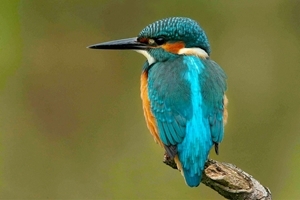Kingfisher
 You might have heard the term ‘little brown job’ in the world of birds, but did you know that the beautiful blue kingfisher is actually a member of this club too? All will be revealed…
You might have heard the term ‘little brown job’ in the world of birds, but did you know that the beautiful blue kingfisher is actually a member of this club too? All will be revealed…
The common (Eurasian) kingfisher (Alcedo atthedis) hardly needs describing – a favourite of artists and poets, it is one of our most striking and yet seldomly seen birds. It is smaller than you might think (about sparrow size) and the flight is low, direct and fast, so that all most people will see of them is a blue flash. It is said that the kingfisher’s superbly aerodynamic bill inspired the design of Japanese high-speed trains. This long, dagger-like bill needs support from a disproportionately large head, though our kingfisher is rather outdone in this regard by the very top-heavy stork-billed kingfisher, one of the other 90 members of the global kingfisher family!
Its vivid blue and orange plumage looks rather exotic in comparison to the more modest hues of most resident British birds. Probably because it is exotic: A. atthedis – along with seven distinct subspecies – can also be seen in the mangroves of Thailand, spring-water lakes of Hungary, rainforests of India, and almost everywhere in between across central Eurasia and North Africa.
Why is this characteristically blue bird actually a little brown job then? Well, you don’t find pure blue pigmentation in nature very often – in the case of the kingfisher, it is trickery! The colour comes not from pigments, but from physics. The feathers are actually brownish, and they employ a phenomenon known as ‘structural colouration’. Using simple sugars, a feather cell creates a surface nano-structure that optimises reflection of blue light from the sun so it appears electric blue to our eyes. If you find this difficult to believe, just think that you can see all the colours of the rainbow in an otherwise transparent soapy bubble – it’s the same sort of thing!
It’s an intriguing adaptation, and characteristic of many species of birds, butterflies, cuttlefish, oysters, and beetles. Studies of this light-bending capability have informed design of numerous industrial, commercial and military technologies. Who knows – maybe one day MI6 agents could have wearable invisibility cloaks thanks to these creatures?
It’s not just their feathers that are super-advanced. Their eyes have specialised retinal pigments to help them see in murky water, three types of eyelid, and a special egg-shaped lens. The latter two adaptations allow them to see individually in the air to locate prey, but when they dive into the water they switch to binocular vision, using both eyes to judge distance of the target. Fish are their main diet, supplemented by tadpoles, small amphibians, beetles, shrimps and insect larvae. All of these can be found in clear, slow-flowing water with luxuriant vegetation.
Kingfishers are one of the top predators in the river corridor, so they are often seen as indicators of river health. They require a bountiful territory to survive, because they need to consume over 60% of their bodyweight a day – roughly 16 minnows! For this reason they are fiercely territorial, and this even extends to their offspring once they are big enough to be a competitor. When rivers are fully occupied, some birds are even ousted to ‘experimental’ territories such as garden ponds, woodland brooks or coastal rockpools.
Fishing gets harder in the winter when watercourses become turbid with runoff, and when flooded or frozen, so spare a thought after the crazy autumn we had (many more of those and we’ll all evolve gills!). But there is no let-up in spring either; males have to catch and offer fish to woo females – called a ‘fish pass’ – and when they have a brood of half a dozen chicks, they may have to catch up to 100 fish a day between them.
Kingfishers make nest burrows in the sheer and bare face of a riverbank, to protect young from predators. They dig a tunnel over a foot into the soil using their beak, whilst shuffling out the spoil with their feet. They may have two or three broods in a year, which take six weeks each to raise, and this high turnover is necessary because youngsters suffer from high mortality rates. They are sometimes forced to leave and fish for themselves before they are physically ready, and drown. Despite this harsh strategy, numbers of kingfishers are relatively stable at 4,000-6,000 pairs in the UK, and it’s hoped they are benefitting from widespread efforts to improve river morphology and water quality.
So, there you are – a fascinating little bird. Some say that kingfishers are a good omen, so I hope you catch a glimpse one day if you haven’t seen one before. If you are lucky and get a good look at its bejewelled blue beauty, will you believe it is an illusion?
Jess Brooks
Advisory
Photo credit: Ian David

Get Peter Thompson's essential 26-page book, featuring beautiful photography and detailed profiles of Britain's wildlife, for just £1.99.
Find out more >